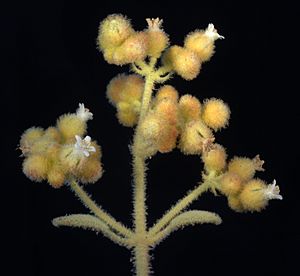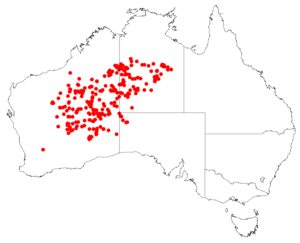Dicrastylis exsuccosa facts for kids
Quick facts for kids Dicrastylis exsuccosa |
|
|---|---|
 |
|
| Dicrastylis exsuccosa | |
| Scientific classification | |
| Genus: |
Dicrastylis
|
| Species: |
exsuccosa
|
 |
|
| Collections data (AVH): D. exsuccosa | |
| Synonyms | |
|
Dicrastylis exsuccosa f.albolutea Munir |
|
Dicrastylis exsuccosa is a special type of flowering plant that grows in the dry, inland parts of Australia. It belongs to a group of plants called Dicrastylis and is part of the Lamiaceae family. You can find this plant in Western Australia, the Northern Territory, and South Australia.
About Dicrastylis exsuccosa
Dicrastylis exsuccosa is a shrub that usually grows between 0.3 and 1.5 meters (about 1 to 5 feet) tall. It likes to grow in sandy areas, like sand-dunes and wide-open plains. This plant blooms with flowers from April all the way through November.
Its leaves grow in pairs, opposite each other on the stem. Each leaf can be from 1 to 10 centimeters (about 0.4 to 4 inches) long and 1 to 2 centimeters (about 0.4 to 0.8 inches) wide. The leaves are covered with tiny, branch-like hairs, and their edges are smooth. The stems are mostly round when you look at them in a cross-section.
The flowers of Dicrastylis exsuccosa are usually white or cream-colored. Each flower has five stamens, which are the parts that produce pollen. It also has a five-lobed calyx, which is the green, leaf-like part that protects the flower bud. The main part of the flower, called the corolla, is what gives it its white or cream color.
In Western Australia, you can find this plant in many dry regions. These include areas like the Little Sandy Desert, Gascoyne, Central Ranges, Gibson Desert, Great Sandy Desert, Tanami, Great Victoria Desert, and Murchison.
Plant Classification
The way scientists classify plants is called taxonomy. This helps us understand how different plants are related to each other.
Dicrastylis exsuccosa was first described in 1858 by a scientist named Mueller. He originally placed it in a different group of plants, calling it Pityrodia exsuccosa. Later, in 1917, another scientist named Druce moved it to its current group, the genus Dicrastylis.
Images for kids





